Pre-Raphaelites at Delaware Art Museum
Post #1106 • January 2, 2008, 12:57 PM • 22 Comments
Wilmington, DE - Delaware is an important landmark for American illustration. Howard Pyle was born in Wilmington, and the states of Delaware and Pennsylvania saw nearly every major American illustrator of the late 19th and early 20th Centuries come through either as a teacher or a student. It seems fitting that Wilmington is also home to a major collection of works by one of the most illustrative movements of fine art, Pre-Raphaelitism. In 1935 a local textile magnate bequeathed his considerable Pre-Raphaelite holdings to an early incarnation of the Delaware Art Museum. These objects and ones acquired since then just returned home from a nine-city tour last September, where they have been opulently and permanently installed.
The ingredients that went into Pre-Raphaelitism ought to have cancelled each other out. Such pairings include narrative and Art for Art's Sake, Medieval faith and Renaissance empiricism, religiosity and lust, and diverse ranks in the Brotherhood (including a Greek woman and a Jew) coupled with a fetish for a particular copper-headed type with skin as white as fired porcelain. Throw in, for good measure, the notion that art had been going downhill since the cinquecento, and the whole project looks positively nutty.
And yet it all works in its way. Despite the numbing detail and cornball theatricality, great art gets through here and there, evidence that art doesn't care what artists get excited about as long as they get excited about something. This movement was the last to attempt aesthetic heights through illusionist realism until the Photorealists, and where the compositions as a whole don't get sucked down by the effort, they succeed. Rossetti, especially, gives one the impression of bathing in jewels, rather than being pelted by them. The exhibition does fine work presenting a range of objects, including the books so important to the movement, and makes the Delaware Art Museum a required destination for those of us who enjoy this work in the way that we enjoy occasional listenings of heavy metal, and for largely the same reasons. See more at the website.
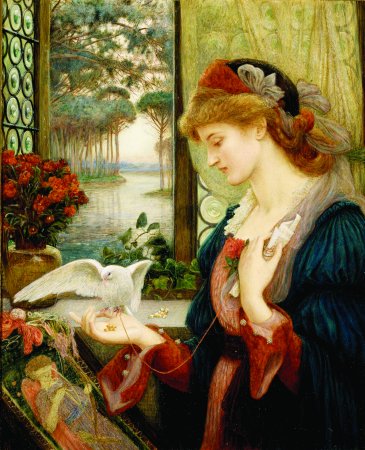
Marie Spartali Stillman (1844-1927): Love's Messenger, 1885, watercolor, tempera, and gold paint on paper mounted on wood, 32 x 26 inches, Samuel and Mary R. Bancroft, Memorial, 1935
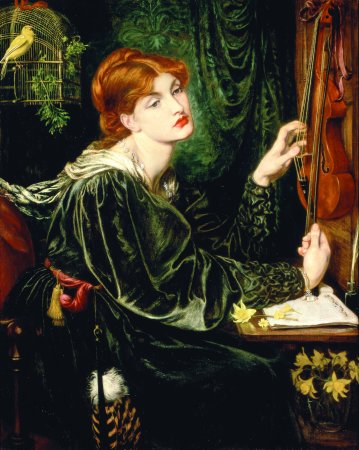
Dante Gabriel Rossetti (1828-1882): Veronica Veronese, 1872, oil on canvas, 43 x 35 inches. Samuel and Mary R. Bancroft Memorial, 1935
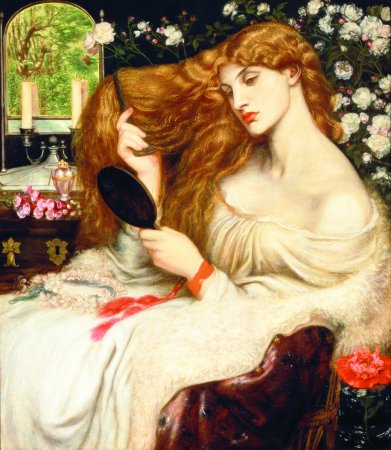
Dante Gabriel Rossetti (1828-1882): Lady Lilith, 1866-68 (altered 1872-73), oil on canvas, 38 x 33 1/2 inches, Samuel and Mary R. Bancroft Memorial, 1935
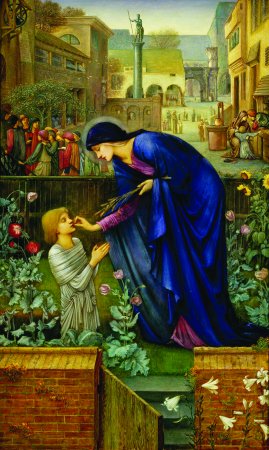
Sir Edward Burne-Jones (1833-1898): The Prioress' Tale, 1865-98, gouache on paper on linen support, 47 1/2 x 31 1/2 inches, Samuel and Mary R. Bancroft Memorial, 1935
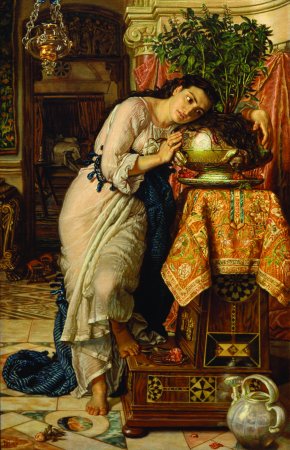
William Holman Hunt (1827-1910): Isabella and the Pot of Basil, 1867, oil on canvas, 31 1/2 x 23 inches, Special Purchase Fund, 1947
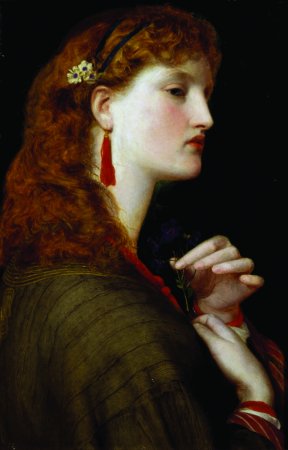
Frederick Sandys (1829-1904): May Margaret, 1865-6, oil on canvas, 26 3/4 x 20 5/8 inches, Samuel and Mary R. Bancroft Memorial, 1935
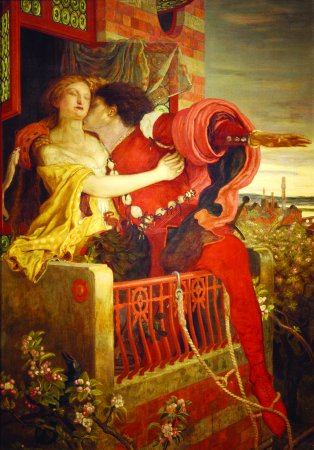
Ford Madox Brown (1821-1893): Romeo and Juliet, 1870, oil on canvas, 53 3/8 x 37 inches. Samuel and Mary R. Bancroft Memorial, 1935
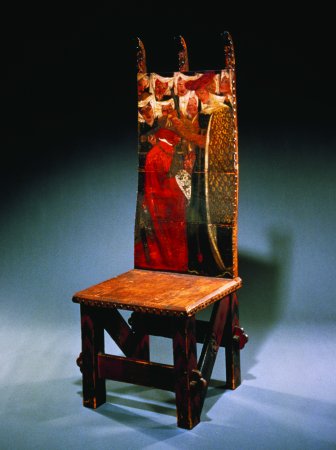
William Morris (1834-1898); Dante Gabriel Rossetti (1828-1882): The Arming of a Knight, 1856-57, painted deal, leather, and nails, 55 5/8 x 18 3/4 x 19 1/2 inches, acquired through the bequest of Doris Wright Anderson and the F. V. du Pont Acquisition Fund, 1997
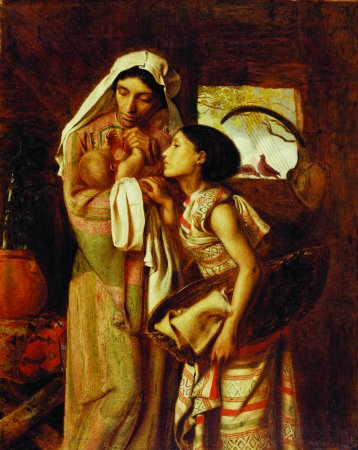
Simeon Solomon (1840-1905): The Mother of Moses, 1860, oil on canvas, 24 x 19 7/8 inches, bequest of Robert Louis Isaacson, 1999
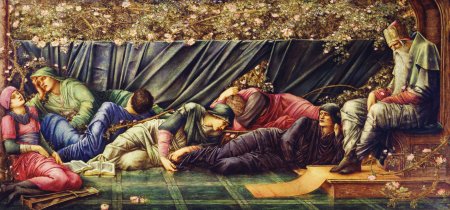
Sir Edward Burne-Jones (1833-1898): The Council Chamber, 1872-92, oil on canvas, 49 x 104 inches, Samuel and Mary R. Bancroft Memorial, 1935
2.
January 2, 2008, 3:08 PM
There are good Pre-Raphaelite pictures, especially if one can take them on their own terms, such as the early work of Millais, some Rossetti, some Holman Hunt, a few things by lesser names like Arthur Hughes and even by the later Pre-Raphaelites, notably Waterhouse (who, as OP says, could paint for sure; his Ophelia is delicious--like very fine white chocolate).
But yes, there is more chaff than wheat. These were, after all, Victorian British painters. It is also worth noting that the movement's great early champion was Ruskin, generally considered the most important English critic of the 19th century. He was also, and rather more to his credit, a great admirer and promoter of Turner. Go figure.
3.
January 2, 2008, 3:10 PM
the second 2 give you and idea of where maybe renoir got his poses and some of his color from. even so renoir would look better for it with his hazy flatish painterly technique.
the frederick sandy's looks best to me.
4.
January 2, 2008, 3:24 PM
I would go for the Rossettis, probably, of what is pictured here, but I like Millais & Hunt better, as I recall.
5.
January 2, 2008, 3:25 PM
Of the images posted by Franklin, the Sandys does indeed come off best, in part because it is the simplest and least "loaded," and in effect the most suggestive (the technique, especially the handling of the skin, is not exactly shabby, either). This is, of course, the classic Pre-Raphaelite red-haired "stunner" type Franklin mentioned.
6.
January 2, 2008, 3:29 PM
My vote is for the second Rossetti, and after it, the Burne-Jones gouache. The neck in the Sandys is just ridiculous and the head looks oversized and vacant.
7.
January 2, 2008, 3:38 PM
The Rossettis here, at least as reproduced, are a little too much like Hollywood glamour shots from the 1930s or 40s, impressive as artificial perfection but ultimately a little too slick and plastic. In person, however, they may be warmer or more sensual than these photos appear (though the dark green velvet on Veronica is terrific).
8.
January 2, 2008, 3:42 PM
this whole group is quite a collection of necks. it most have been a pre-raph trait. as well as that come hither blank stare.
9.
January 2, 2008, 3:44 PM
Franklin, a goddess can have as long a neck as she damn well pleases. This is, after all, a male fantasy figure. I agree she doesn't look like Marie Curie, but the impassive self-absorption is part of the "stunner" ethos.
10.
January 2, 2008, 7:05 PM
Hunt and Burne-Jones have always been my favorites among the Pre-Raphaelites, but I should emphasize that I do not think this is saying much. Raphael makes me feel happy and satisfied and awe-struck, so why bother with the Prees.
11.
January 2, 2008, 7:12 PM
I also admire William Morris' tapestries and his utopian novel "News From Nowhere".
12.
January 2, 2008, 7:15 PM
Are shallow, stage-like spaces part of the PRB MO too? Or, is it just a coincident feature of this selection? Any relation to this observation, and modern painting's direction towards increased flatness...?
13.
January 2, 2008, 7:57 PM
Marc, "stage-like spaces" are definitely part of their M.O. I consider their paintings of women to be very nicely painted, masturbatory arrangements, done with a Victorian and therefore repressed sensibility. Just imagine the metaphysical and profound stage like settings of Quattrocento paintings, done by a bunch of horny and repressed Englishmen, who painted more realistically, but still let their fetishes dictate how they composed the female figure. There is something perverted about their images of women, and this contradicts the idyllic flora and fauna they cram into each image. The saccharine quality of the work sours pretty quickly for me. I am not enchanted, but as Jack notes, there are some really nicely painted passages.
14.
January 3, 2008, 4:58 AM
... art doesn't care what artists get excited about as long as they get excited by something.
That's a great way to put the general principle, Franklin, and it rings true loudly. But great art gets through here and there ...?
I have found over the years that many who like the Pre-Raphaelites REALLY like them. They have something that inspires a special kind of devoted admiration, certainly. But "greatness" goes too far. Eric nailed that aspect in #10.
And Marc also nailed the illusionist issue in #12: "realism" as we understand it since the camera, does not seem to apply with much consistency. That said, whether the Pre-Rs were realists or not doesn't bear on how good they were. Nor did I sense that Marc was saying that.
15.
January 3, 2008, 5:58 AM
I think the biggest contribution of the Pre-Ralphs to the modernist movement is their fetishization of historical content, their realism (albeit a heavily qualified one [see neck comments above]) and their theatricality (which can be attributed to Renaissance and pre-Renaissance Italian and German art). Their references to the history of painting are very self conscious as well, and of course this sort of thing (not due to the Pre-Ralphs necessarily) has all but submerged contemporary painting into an airless, ironic vat.
Critics and curators go batty over any painter who comes along and paints as well the weakest of the Pre-Ralphs (Currin, et. al). Their biggest contribution to art history overall, when looked at from a contemporary vantage point, is there obsessive qualities, their show-offy technique. It is sad how the Pre-Ralphs reaped a lot of scorn from the art establishment in the past, but now general audiences are hungry for their capable technique and lush realism.
Clearly they were dedicated, I think in an obsessive, occasionally tender, and often perverse manner. Sex and death drove their art. That is why it is appropriate that opie brought up heavy metal music in this context. Obviously some of them were talented painters, able to capture textures and exacting tonal values with their brushes. To me their hopeless pining for the past, their transforming every woman they painted into a symbol of death or something else slightly less morose, is rather thin gruel.
Like I said I would take the Quattrocento and Renaissance masters any day of the week over them. However, their Romanticism, their passion and drive for the ineffable is definitely needed in the present in some form or other (of course the Pre-Ralphs world view is gone forever). There is definitely a longing for the pre-industrial world present in almost all of their paintings, a longing for the clarity of Medieval hierarchy and its code of ethics.
16.
January 3, 2008, 6:45 AM
But "greatness" goes too far.
Sometimes it's just the expanse of one sleeve or one flower or one lock of hair, but that one expanse wants for nothing. That's more or less the upper limit of PRB greatness. And of course, great parts do not sum up to great wholes in art.
That is why it is appropriate that opie brought up heavy metal music in this context.
Hey, I'm the one who brought up metal. I want credit for that. :) These paintings are marked by superlative technique, overwrought feeling, and theatrics. I can almost hear Crüe playing behind them.
17.
January 3, 2008, 7:21 AM
That's right, Franklin. I was responding to something you said in the post.
Eric, you repeat the term "Pre-Ralph". Is this a given term of some kind? Sounds sort of like a way to describe business before Nader, or literature before Emerson.
Marc's observation about flatness is an excellent observation. Could almost be a PhD dissertation. I think the staginess and the little "windows into distance" comes about through their literally referring back to painting before Raphael, when painting was doing its damndest to establish convincing illusion. Same problem; different response.
18.
January 3, 2008, 8:03 AM
it is amazing that everyone pretty much or more sees these the same way. where's george?
19.
January 3, 2008, 8:21 AM
Sorry I must have been thinking about the Honeymooners or something. I think I am being more generous than I would normally be towards these painters because it is the topic at hand, what we are all currently discussing. I really have no interest in this particular school of painting. And in response to opie's comment: "...their literally referring back to painting before Raphael..." is partially true. I think they refer to Renaissance painting just as much as to pre-Renaissance painting. As for English painters with superlative technique, I will take Constable, Turner, Gainsborough, and Reynolds over the Pre-Raph dudes any day.
20.
January 3, 2008, 9:26 AM
The Pre-Raphaelites dismissively referred to Sir Joshua Reynolds as "Sir Sloshua."
21.
January 3, 2008, 9:33 AM
That showed him!
22.
January 3, 2008, 1:18 PM
It's good that these images of the work have been republished here because the little zoomable window at the DAM site makes them all but unviewable.
I'm having trouble categorizing these images all under Pre-Raphaelism. Paying no attention to captions, their most unifying characteristic seems to be the blending of a spate of different eras and places, ancient to modern spanning continents.
But the ones I like I can point to: Rosetti's Veronica Veronese (which seems to me something of a Dutch Baroque Nouveau mashup), and Hunt's Isabella and the [Basin of Pot] (with its Romantic Michaelangelesque figure in the Flemish style).
1.
opie
January 2, 2008, 2:14 PM
Well, I don't like heavy metal, not even in minute doses, and I find Preraphaelite painting turgid, arty and depressing, but they did know how to paint, for sure.